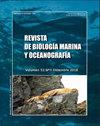Dimensiones espacial y temporal de los procesos de selección de hábitats críticos por las tortugas marinas
IF 0.5
4区 生物学
Q4 MARINE & FRESHWATER BIOLOGY
引用次数: 2
Abstract
espanolLas tortugas marinas son especies de grandes vertebrados que tienen un ciclo de vida complejo en el que ocupan diversos habitats durante sus distintos estadios de vida. Tal complejidad impone retos para el estudio y conocimiento de sus poblaciones, y por decadas numerosas investigaciones se han dedicado a entender los factores que determinan la seleccion y uso de los recursos que requieren en sus diferentes etapas. La concepcion a una escala espacial y temporal de los esfuerzos de investigacion es de suma trascendencia para obtener informacion robusta y pertinente sobre los procesos de seleccion de sus habitats. El objetivo de esta revision fue analizar diferentes escalas y aproximaciones abordadas para la evaluacion de los procesos de seleccion de playas de anidacion, sitios de anidacion y habitats de alimentacion por las tortugas marinas, considerando algunas de las implicaciones biologicas, ecologicas y evolutivas asociadas a dichos procesos. A partir de resultados publicados se analizan algunos de los resultados reportados y las implicaciones que estos procesos tienen en temas de conservacion y manejo de sus poblaciones y habitats criticos. El estudio de los procesos de seleccion y uso de los habitats criticos que ocupan las tortugas marinas es una linea actualmente vigente, pertinente y de alta relevancia, a traves de la cual se reitera la importancia estrategica y fundamental de estudios de monitoreo a largo plazo, unica manera de evaluar de forma contundente modificaciones en sus poblaciones y habitats a escalas espaciales y temporales distintas. EnglishMarine turtles are large vertebrates with a complex life cycle along which they occupy several habitats in their different stages. This complexity imposes challenges for the study and knowledge of their populations, and for decades numerous studies have targeted to understand the factors that determine the selection and use of the resources they require at their different stages. The inclusion of the spatial and temporal scales in the conception of the research efforts is of the highest transcendence to obtain robust and pertinent information about the habitat selection processes. The objective of this revision was to analyze different scales and approaches used to evaluate the selection processes of nesting beaches, nesting sites and feeding habitats by sea turtles, considering some of the biological, ecological and evolutive implications linked to these processes. Based on the available literature, some of the reported results are analyzed in terms of their implications for conservation and management of their populations and the critical habitats they occupy. The study of the processes involved in the selection and use of the critical habitats that sea turtles occupy is nowadays an active, pertinent and of highest relevance; fact that reassert the strategic and fundamental importance of long time monitoring studies, as the only way to evaluate in a convincing way alterations of their populations and habitats at different spatial and temporal scales.海龟选择关键栖息地过程的时空维度
西班牙海龟是一种大型脊椎动物,其生命周期复杂,在不同的生命阶段占据不同的栖息地。这种复杂性对研究和了解其人口构成了挑战,几十年来,许多研究都致力于了解决定其不同阶段所需资源的选择和使用的因素。在空间和时间尺度上构思研究工作对于获得有关其栖息地选择过程的可靠和相关信息至关重要。这一修订的目的是分析不同的尺度和方法,以评估海龟筑巢海滩、筑巢地点和觅食栖息地的选择过程,同时考虑到与这些过程相关的一些生物、生态和进化影响。根据公布的结果,分析了一些报告的结果以及这些过程对保护和管理其关键种群和栖息地问题的影响。对海龟居住的关键栖息地的选择和使用过程的研究是一条目前有效、相关和高度相关的路线,通过这条路线,它重申了长期监测研究的战略和基本重要性,这是在不同的时空尺度上有力地评估其种群和栖息地变化的唯一途径。英国海龟是大型脊椎动物,生命周期复杂,在不同阶段占据几个栖息地。这种复杂性对其人口的研究和知识提出了挑战,几十年来,许多研究的目的是了解决定他们在不同阶段所需资源的选择和使用的因素。将空间和时间尺度纳入研究工作的概念对于获得有关生境选择过程的有力和相关信息至关重要。这一修订的目的是分析用于评估海龟筑巢海滩、筑巢地点和觅食生境选择过程的不同尺度和方法,同时考虑到与这些过程有关的一些生物、生态和进化影响。根据现有文献,分析了一些报告的结果对保护和管理其人口及其占用的关键生境的影响。研究海龟占领的关键栖息地的选择和使用过程,现在是一项积极、相关和最相关的工作;事实上,它重新强调了长期监测研究的战略和根本重要性,认为这是以令人信服的方式评估其人口和生境在不同时空尺度上变化的唯一途径。
本文章由计算机程序翻译,如有差异,请以英文原文为准。
求助全文
约1分钟内获得全文
求助全文
来源期刊
CiteScore
0.70
自引率
0.00%
发文量
41
审稿时长
12 months
期刊介绍:
Publicar desde una perspectiva científica, artículos originales, decididos por un proceso de revisión por pares, invitando a expertos de reconocido prestigio en el área. Los trabajos publicados se caracterizarán por su solidez teórica-metodológica, actualidad y relevancia para las ciencias marinas.
Se reciben trabajos inéditos derivados de la investigación científica realizada en ambientes marinos y estuarios, en formato de Revisión, Artículos, Notas Científicas, y Obituarios en las siguientes disciplinas::
Biología-Ecología marina
Oceanografía física, química y biológica
Contaminación marina
Geología marina
Sistemática, Faunística y Biogeografía Marina
Manejo Costero
Acuicultura marina
Pesquería marina.

 求助内容:
求助内容: 应助结果提醒方式:
应助结果提醒方式:


